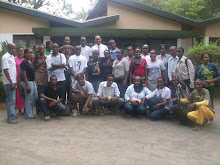In Courtesy of Birdlife International May 2008, Tata Chemicals Ltd (TCL) has finally withdrawn its much discredited Environmental and Social Impact Assessment (ESIA) Report for the proposed Lake Natron soda ash plant. The development has been opposed by national NGO's in Tanzania, the Lake Natron Consultative Group (a consortium of 32 mainly East African NGOs), BirdLife International and the Royal Society for the Protection of Birds (RSPB; BirdLife in the UK), for posing serious threats to the survival of Lesser Flamingos Phoeniconaias minor and the livelihoods of local communities.
In an apparent response to these concerns, the company hold a stakeholders meeting hosted by the World Bank in Dar es Salaam last week that they had asked the Tanzanian government to disregard the earlier report. Mr Rahul Singh, the new TCL Project Manager, said: “We have turned down the earlier ESIA report and requested the government to throw away the original report as we are working on new studies on the matter.”
Lesser Flamingos
* The lesser flamingo, Phoeniconaias minor, stands between four and five feet high but is the smallest of the six flamingo species. With the greater flamingo, it is one of two Old World flamingo species. The clearest difference between the two species is that the greater flamingo has a pale pink bill with a contrasting black tip while the lesser flamingo has a dark crimson bill. The lesser flamingo is also shorter and redder in colour.
* The species has long pink legs and a long neck. Its large body is rose-pink, the colour coming from pigments in its food, the bacteria Spirulina. The birds eat by holding their bills upside down in the water. Flamingo bills are shaped to filter tiny food items within the bill using a specially adapted tongue.
* Spirulina are cyanobacteria, commonly known as blue-green algae, although in fact they are prokaryotes, not algae, and are actually bacteria. Spirulina sometimes gives Lake Natron a pink or red colour. It grows only in salty lakes.
During the meeting that was attended by a wide range of donors, media, government personalities and the private sector - Lota Melamari, the CEO of the Wildlife Conservation Society of Tanzania (WCST, BirdLife in Tanzania) presented a strong case for the complete abandonment of the project in a presentation entitled "Flamingos of Lake Natron, a Tanzanian Treasure". In his talk, Lota described Natron's vast flocks of shimmering pink flamingos as one of the world's greatest wildlife attractions. "This resource must not be destroyed", said Lota.
Damage to tourism
At the same meeting the Tourism Services Manager of the Tanzania Tourist Board, Ms Serena Shao, warned that Tanzania may not achieve its tourism targets if key attractions are destroyed. "The soda ash proposal must be critically analysed given that Tanzania currently earns over 1billion US dollars from tourism. Our dream of attracting one million tourists by 2010 may not be achieved if we damage key attractions like Lake Natron ", she said.
New environment minister
In response to the investor's withdrawal of the project, the new Environment Minister under Vice Presidents office of Tanzania (Dr Batilda Burian) called a press conference and issued a government statement in which she warned that while the investors were free to conduct a fresh ESIA, they should be aware that unless their report satisfied environmental and social concerns, no approval would be granted. Dr Burian further said that a new ESIA must be preceded by the development of an Integrated Management Plan for the Lake Natron Ramsar Site which would spell out the future conservation and development agenda for the area.
Flamingo facts
1. Flamingos live until they are about 40 years old but only breed every five or six years. Non-breeding birds do not return to breeding sites until they are ready to breed again.
2. The bird lays one chalky white egg on mounds built of mud. Chicks join creches soon after hatching which can number more than 100,000 birds. The creches are marshalled by adult birds which lead youngsters by foot to fresh water to drink, a journey that can be longer than 20 miles.
3. There are thought to be between 2.2 million and 3.25m lesser flamingos in the world of which between 1.5m and 2.5m are found in East Africa. Lack of breeding at Lake Natron will reduce the region’s population.
4. Vagrant birds are occasionally seen in southern Europe.
BirdLife International, the RSPB and the Lake Natron Consultative Group welcome the investor's decision to withdraw the initial ESIA report submitted to NEMC. We also laud the new Minister's quick response and commend her for being responsive to stakeholders in general on this matter. However, we hold the view that Tata Chemicals Ltd and its Tanzanian partner the National Development Corporation should have withdrawn the project altogether.
Shifting the project 32 km away from Lake Natron does not amount to "mitigation" of the serious impacts the project, its likely to pose to the Lesser Flamingos and the local communities. The project impacts are not limited to the operations of the plant alone but the whole process of brine extraction (including an intricate network of pipes and roads on the surface of the lake as is the case at Lake Magadi in Kenya), pumping and processing.
Tuesday, April 13, 2010
Subscribe to:
Post Comments (Atom)


No comments:
Post a Comment